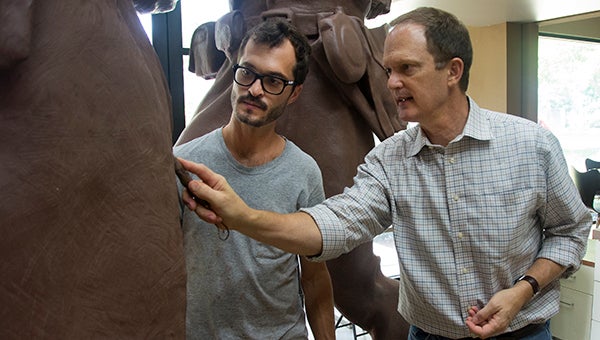In The Presence of Giants: Local artist creates monumental sculpture
Published 10:20 am Friday, July 18, 2014

DAILY LEADER / KATIE WILLIAMSON / Kim Sessums (right) shows his son Jake Sessums how to finish certain areas on “The Monument to Mississippi” sculpture in progress Monday in Sessums’ studio. The sculpture is being made to sit at Shiloh National Military Park to honor the Mississippi troops who died during the battle.
Kim Sessums and his son Jake Sessums work in a room of giants. Three eight-foot Confederate soldiers tower over the men as they form and shape clay around the giant bodies.
Kim and Jake are working to capture the spirit of Mississippians in the Civil War, specifically those who fought in the battle of Shiloh, a task so monumental it would dwarf many artists.
On April 6, 1862, Confederate soldiers stormed federal troops camped around Shiloh hill. The bloody battle, which would lead to the control of the railroad junction in Corinth, lasted two days at the cost of 23,746 men who were killed, wounded or missing; 1,728 of them were Mississippians. This was the largest battle in the Mississippi Valley campaign.
In the sculpture, three Confederate soldiers proudly carry their flag into the battle. The color bearer is hit by a bullet and begins to fall as the flanking color guards reach for the flag and offer support to their fallen comrade. Kim Sessums captures the moment of recoil and heroism.
“This grouping would seek to be an action composition, the Color representing all that the soldiers are fighting for and thus must not fall or be lost,” he wrote in his artist’s proposal for the project. “At the falling of the Color Bearer, the guards and their comrades are reminded in an instant of their reason to be in the midst of all the death and destruction around them … duty and honor to push forward to victory or death.”
Kim Sessums begins every sculpture with research. The counters in his studio are lined with Civil War history books and narratives he references with every detail, which results in a sculpture that is meticulously true to the period. He said that each detail will become a conversation piece for Civil War buffs because of the accuracy.
Sessums has modeled his three soldiers after sixth Mississippi regiment with a Hardee pattern flag. Every minute detail is historically accurate, from the button on a solder’s satchel to the bridle pike cutter atop the flagpole. To properly represent the physicality of the figures in a pose, Kim had three men act out the scene as he took photos to study the exact muscular systems of each performer.
“All the elements are implemented to give an overall narrative,” Sessums said. He added that even though everything is historically accurate, the actual men are fictional and by doing this, the piece does not reflect any individual, it reflects Mississippi Confederate solders as a whole. He is representing the anonymous Confederate solders, who lost their lives “struggling in the ultimate sacrificial way for a cause.”
Unlike the majority of his work, Sessums competed for the chance to erect the monument in honor of Mississippi soldiers at the Shiloh National Military Park. Since the founding of the park in 1894 there have been monuments for Alabama, Arkansas, Illinois, Iowa, Kentucky, Michigan, Missouri, Texas and Wisconsin. Sessums’ sculpture will join as the tribute to Mississippi.
“As an artist you go to these national parks to see the great turn of twentieth century figurative sculptures,” he said. “Not everyone can be there; pieces there last forever.”
This will be the fifth monumental statue constructed by the artist. Previous ones include a tribute to black troops at the Vicksburg National Military Park and the six-foot statue of the legendary football coach John Vaught on the University of Mississippi campus. However, this is the first time his son has been involved in the process.
“I’ve really enjoyed it, seeing the beginning and seeing it as it comes together,” said Jake. “I never thought about what went into these works. I thought it was something he could just do.”
Jake has been doing the majority of the manual labor involved in working with the giants, while also witnessing the process of how his father works in the studio.
“I’m giving him the assistance he needs to finish in a timely fashion,” said Jake. “I’m working harder than I normally would because this is part of my history, too, and I want to add to it. I learn as much as I can when I can.”
Kim and Jake are about five months into the sculpting process, not including the three months Kim spent researching. The deadline for completion is April 6, 2015, when it will be unveiled at Shiloh on the battle’s 153rd anniversary. The preparation includes six months at the bronze foundry.
Currently, the two men are adding and sculpting clay around the giant armature. They are using small loop tools, knives and bristle brushes to carve every detail, perfect every fold, crease, and line, and to give a subtle texture to the piece that adds another dimension to the work.
“The big projects are more complicated to maintain the integrity of design,” said Kim. “It needs to look like it was created, scored and patina applied by the same artist’s hand. I don’t want an inconsistent design.” He added that it’s a balance to have both personalities in the piece but with the same intentions.
Sculpture is not Kim’s only artistic passion. He is also a talented two-dimensional artist, who utilizes several different media to create figurative work. Every art piece he creates conveys an emotion or idea, even if they are only understood by him. Nothing is objective.
Kim began drawing at an early age. He grew up in a small town in rural Mississippi. His work pays tribute to the Southern people who have in someway made an impact on him throughout his life. Even the smallest of his sketches has a remarkable amount of detail and reality that conveys an intimate connection he has with every subject.
Besides all this, Kim is also a local full-time OBGYN for the Brookhaven community at King’s Daughters Medical Center. He has been practicing medicine for 25 years and has a passion for the medical field as well his art. It’s mind-boggling, but he balances patients with pencils. Throughout his medical career, he has never stopped creating art.
Kim said that he has gotten his brain to work in small amounts of time. It’s not easy for him to find six-hour increments to work on his sculpture projects, but all those 45-minute sessions add up over time.
“He lives a life of no wasted time,” said Jake.
The two men will continue their sculpting work on the Confederate giants until it’s time to send them to the foundry, where the work will be bronze cast in 18 sections and reassembled as a whole. The monument will find its final resting place with fallen soldiers at Shiloh National Park. The three color guards represent the Mississippi Confederates, Mississippi and, of course, the Sessumses.
“Monuments attempt to express what is honorable and transcendent about and within our humanity,” wrote Kim.
Echoing the words of Abraham Lincoln, The Mississippi Monument at Shiloh is yet another reminder that these dead have not died in vain and that this nation has not perished.




